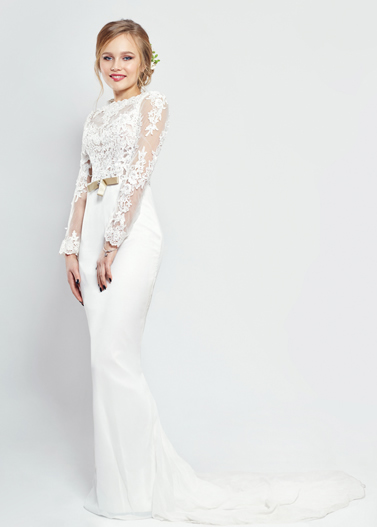
Wedding Dress Timeline
You may have fantasized about your dream dress since you were a little girl. But chances are, you haven't yet considered all the practicalities of actually finding one. From setting a budget to your final fitting, this handy wedding dress timeline covers everything you need to do and will help keep you ahead of schedule.
10-12 months before
Set a budget. Decide how much of your wedding budget you can spend on your dress. Having a set budget ahead of time will help your bridal store consultant pull the right dresses for you to try on. (In addition to the cost of dress and possible alterations, set aside part of that budget for accessories such as shoes, headpiece/veil and jewelry.)
Research styles. To help kickstart your shopping, browse through photos of gowns to get a sense for the styles and details that might best match your personal taste. Also, start out with a general idea of the kind of dress you like: traditional, straight, princess line, etc.
Select your shopping mate(s). We all know that too many cooks spoil the soup - same applies when shopping for a gown. Bringing along an army of well-meaning friends or relatives is usually a mistake; too many differing opinions can make the experience too time-consuming and too stressful. Invite one or two trusted partners – your mom, a close friend, etc. – for a second opinion.
Start shopping. Now’s the time to start shopping for your wedding dress! Schedule your appointments early since salons can get booked up fast. Bring photos of dresses you like so the salesperson will be better equipped to help you. Also, keep an open mind. Try on as many different styles as you can. Lots of dresses have zero hanger appeal, but look great once you put them on. Ask to try on a veil with the dress and consider accessories to complete the look, such as jewelry or sashes. These touches just might turn a dress from ordinary to special.
9 months before
Buy your gown. Around the nine-month mark is the time to make a final decision on a gown. Many bridal gowns have to be special ordered, and it can take up to six months to order certain dresses. Plus, you’ll need time for alterations. So, give yourself enough time by putting down a deposit on the dress as soon as you know it’s “the one.” Make sure all the details of your gown order (and any promises the shop makes about delivery, sizing, etc.) are in writing before you place your deposit.
5-6 months before
Select your bridal shoes. Think about the style of your shoes: whether or not you want a heel may affect the whole look of your dress. If you’re having the dress altered to your shoe height, changing to a lower heel shoe for the reception could mean your dress will be too long. Also, know that you’ll be on your feet for most of the day, so make sure your feet can handle it. Consider breaking in your shoes by wearing them an entire day at home.
Decide on any accessories. Choose your accessories now, including the jewelry, veil, hair accessories or other adornments. You’ll want to bring these items to your first fitting so you can see your entire look from head to toe.
Shop for your undergarments. It’s a good idea to purchase your undergarments now so you can wear them for your first fitting appointment. That way, you can make sure everything fits properly and you’re comfortable. Even a slight switch in your undergarments can change the fit of your dress.
3 months before
Schedule your first fitting. You’ll most likely have three fittings to ensure the wedding dress fits you perfectly. Most gowns will need some sort of alterations in order to fit a bride’s shape and form. Don’t plan these fittings too early – you may lose or gain weight after your gown is altered and end up with a gown that doesn’t fit properly. Planning the first fitting around three months prior to your wedding day will ensure plenty of time for alterations. Keep in mind that your dress should just barely sweep the floor –- any longer and you could risk tripping on the fabric.
6 weeks before
Schedule your second fitting. About a month before your wedding day is a good time to plan your second fitting. This gives you time in case the gown doesn’t fit exactly as you envisioned after the first alterations have been made. If something still doesn’t feel right be sure to speak up, so you can stick to your wedding dress timeline.
Planning to add a keepsake? If you want to include a “something old, new, borrowed or blue” item in your gown (such as a blue ribbon or a piece of your grandmother’s dress), plan to have these items before your final fitting. That way, your seamstress can add them while doing other alterations.
3 weeks before
Schedule your final fitting. This final fitting gives your seamstress enough time to make any small alterations.
1-2 weeks before
Take your wedding dress home. It’s finally time to take your dress home! Inspect the dress to make sure everything looks right. Then store it in a breathable, opaque bag (so your future spouse won’t see it) and hang it in a secure spot (where pets can’t dirty it or tear it). If your veil is in the same bag, keep it wrapped separately to avoid any snags.
Day before
Time for those final touches. Gather your dress, bridal accessories and an emergency kit (safety pins, tape, etc.) and keep them all in one place to be safely transported to your wedding venue. Consider investing in a portable handheld steamer to help get your gown wrinkle-free on the morning of your wedding day.
Wedding day
Get dressed! Hurray, the big day is here! Steam your gown and get dressed (allow around 30 minutes). Now, go rock that dress! Enjoy every moment!








